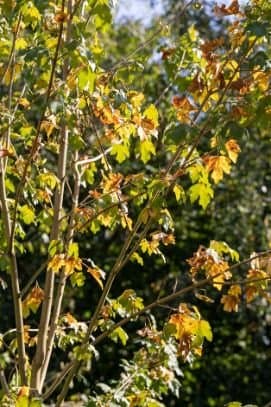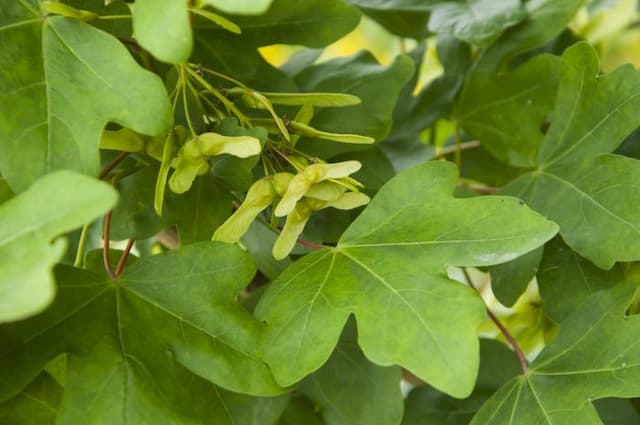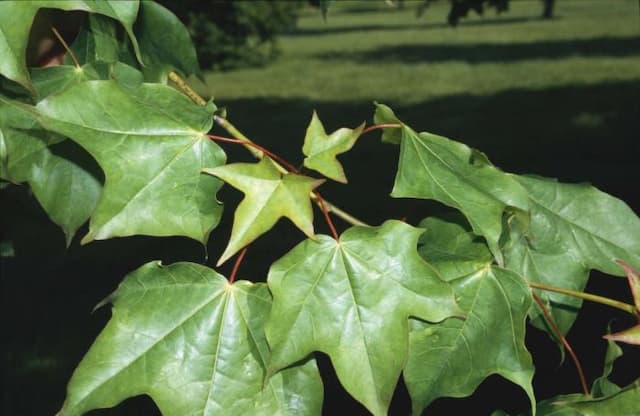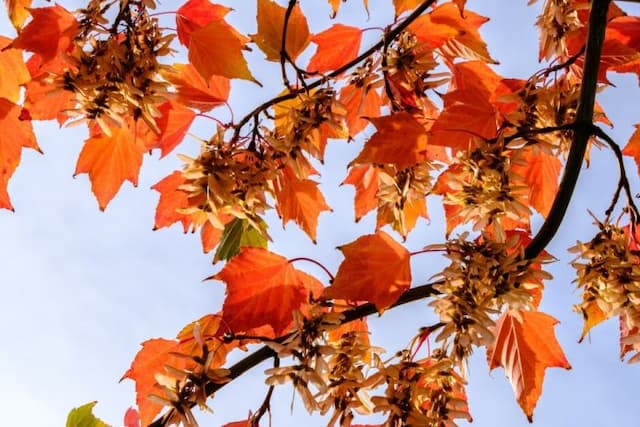Japanese maple Acer palmatum 'Seiryu' (D)

ABOUT
The 'Seiryu' Japanese Maple is an ornamental plant with a unique appearance. Unlike many other Japanese maples that have the traditional palm-shaped leaves, 'Seiryu' has finely dissected lacy leaves, giving it a delicate and feathery look. The leaves are arranged in an opposing fashion along the branches and are intricately detailed. In spring, the foliage emerges in bright green hues, providing a fresh and vibrant appearance. As the seasons progress, the leaves undergo a captivating transformation, displaying a mix of colors. In the autumn, the foliage turns to brilliant shades of red, orange, and sometimes yellow, creating a spectacular display. The branching structure of 'Seiryu' Japanese Maple is upright and somewhat vase-shaped, with a graceful and somewhat open appearance that allows the intricate leaves to stand out. During the winter, when the leaves have fallen, its intricate branch structure is revealed, showcasing an appealing architectural form that adds winter interest to any garden space. In terms of texture, this Japanese maple variety is fine and soft to touch. The contrast between its delicate leaf structure and the strength of its woody branches offers a fascinating juxtaposition, making 'Seiryu' Japanese Maple a standout specimen in the landscape. This is enhanced further by the subtle colors that the bark exhibits. Moreover, the 'Seiryu' Japanese Maple can bear small, attractive blossoms during its flowering season. The flowers are subtle and often overshadowed by the striking foliage. Following the blossoms, winged seed pods, known as samaras, can form and gently dangle from the branches, adding another layer of visual interest to this elegant deciduous tree.
About this plant
 Names
NamesFamily
Sapindaceae.
Synonyms
Seiryu Japanese Maple, Seiryu Upright Japanese Maple, Laceleaf Japanese Maple, Cutleaf Japanese Maple.
Common names
Acer palmatum 'Seiryu'
 Toxicity
ToxicityTo humans
The Japanese Maple is generally not considered poisonous to humans. Contact or ingestion typically does not lead to serious illness or symptoms of poisoning. However, as with any plant, individual allergic reactions or irritations could occur in rare cases.
To pets
The Japanese Maple is largely regarded as non-toxic to pets, including cats and dogs. There shouldn't be serious risks if pets happen to chew on the leaves or other parts of the plant. Despite this, some pets may have an individual sensitivity to plants and could potentially exhibit mild gastrointestinal upset if ingested.
 Characteristics
CharacteristicsLife cycle
Perennials
Foliage type
Deciduous
Color of leaves
Green
Height
12-15 feet [3.7-4.6 meters]
Spread
6-10 feet [1.8-3 meters]
Plant type
Tree
Hardiness zones
5-8
Native area
Japan
Benefits
 General Benefits
General Benefits- Ornamental Value: Adds aesthetic appeal to gardens with its delicate, lacy foliage and vibrant seasonal colors.
- Seasonal Interest: Offers year-round interest with its changing foliage colors - bright green in spring, rich red or purple in fall, and sometimes interesting bark in winter.
- Shade Provider: Creates dappled shade in the garden, which can lower local temperatures and provide a cool area during hot days.
- Habitat Support: Can provide a habitat and food source for various species of birds and insects.
- Compact Growth: Its relatively small size makes it suitable for smaller gardens or for growing in containers.
- Moderate Maintenance: While some care is required, it does not demand extensive maintenance practices.
- Privacy Screen: When planted in groups, it can act as a privacy screen.
- Soil Erosion Control: The root system can help to stabilize soil and prevent erosion.
 Medical Properties
Medical PropertiesThis plant is not used for medical purposes.
 Air-purifying Qualities
Air-purifying QualitiesThis plant is not specifically known for air purifying qualities.
 Other Uses
Other Uses- Acer palmatum 'Seiryu' can be utilized as a natural dye for fabrics, providing a range of colors from greens to browns depending on the mordant used.
- In bonsai, the Japanese Maple 'Seiryu' is often used for its delicate foliage and fine branches, creating a miniature landscape that captures the beauty of nature.
- As an inspiration for art and photography, the distinct leaf shape and beautiful fall coloration can be the subject of paintings, drawings, and photo series.
- The wood of Japanese Maple 'Seiryu' can be crafted into small wooden objects like handles, buttons, or inlays for furniture due to its fine grain and workability.
- In landscape design, this plant’s unique upright form is used to contrast with rounded or horizontal elements, enhancing the visual interest of a garden space.
- During certain festivals in Japan, the leaves of Japanese Maple 'Seiryu' may be floated on water as part of decorative displays known as 'floating leaf' arrangements.
- Its sap can be used as a base for syrups or sweeteners, but this is less common due to the small size of the tree and minimal sap yield.
- Leaf casting is another creative use where the intricate leaves are used to make concrete or plaster molds, which capture the detailed leaf venation patterns for decoration or educational purposes.
- Acer palmatum 'Seiryu' twigs and branches can be incorporated into custom-made wreaths for seasonal door or wall decorations, especially during the autumn.
- As an educational tool, the distinct growth patterns and leaf shapes of Japanese Maple 'Seiryu' may be studied in dendrology and botany courses to illustrate genetic variations and hybridization in plants.
Interesting Facts
 Feng Shui
Feng ShuiThe Japanese Maple is not used in Feng Shui practice.
 Zodiac Sign Compitability
Zodiac Sign CompitabilityThe Japanese Maple is not used in astrology practice.
 Plant Symbolism
Plant Symbolism- Beauty in Change: Japanese Maples, such as the 'Seiryu', are renowned for their striking fall colors, symbolizing the beauty and grace that can come with change and the passage of time.
- Peace: The elegant form and calming presence of the 'Seiryu' Japanese Maple often represent peace and tranquility in the garden or landscape where it resides.
- Balance: The delicate balance between the 'Seiryu's fine leaves and strong structural form can symbolize harmony and balance in life.
- Endurance: Despite its delicate appearance, the 'Seiryu' Japanese Maple is relatively hardy, symbolizing the ability to endure and adapt to life's challenges.
- Japanese Tradition: As a tree native to Japan, it is often associated with Japanese culture and traditions, representing refinement, elegance, and a connection to its cultural heritage.
 Water
WaterThe Japanese Maple 'Seiryu' should be watered deeply once a week, making sure that the soil stays moist but not overly saturated. During hot summer months or dry spells, it may require watering twice a week. Each watering session should consist of about 10 to 15 gallons of water for an established tree, ensuring the water penetrates the soil deeply to reach the roots. It is important to reduce frequency in the fall and further curtail watering in the winter when the tree is dormant. Overhead watering is not recommended as it can promote leaf disease; instead, direct water at the base of the tree to keep the leaves dry.
 Light
LightThe Japanese Maple 'Seiryu' prefers to be grown in partial shade to protect its delicate leaves from the harsh afternoon sun. The best spot for planting is where it can receive morning sunlight and dappled shade in the afternoon. Too much direct sun can lead to leaf scorch, particularly in hotter climates.
 Temperature
TemperatureThe Japanese Maple 'Seiryu' can handle a range of temperatures but thrives best when the temperature is between 60°F and 80°F. It can tolerate a minimum temperature of about -20°F once established but should be protected from harsh winter winds. Prolonged exposure above 90°F can stress the plant, especially if nighttime temperatures do not offer relief from the heat.
 Pruning
PruningPruning the Japanese Maple 'Seiryu' is primarily for shaping and removing dead or damaged branches. The best time to prune is in late winter or early spring before new growth starts. It typically does not require heavy pruning - thinning out crowded branches once a year is enough to maintain its graceful shape and encourage healthy growth.
 Cleaning
CleaningAs needed
 Soil
SoilJapanese Maple 'Seiryu' requires well-draining soil rich in organic matter. A soil mix of 50% pumice, 25% lava rock, and 25% compost works well for this plant. The soil pH should be slightly acidic, ranging between 5.5 and 6.5 for optimal growth.
 Repotting
RepottingJapanese Maple 'Seiryu' should be repotted every two to three years to prevent root bound conditions and refresh the soil. It's best to repot in late winter before new spring growth begins.
 Humidity & Misting
Humidity & MistingJapanese Maple 'Seiryu' is adaptable to various humidity levels but thrives in moderate humidity. Aim for humidity levels between 40% to 70%.
 Suitable locations
Suitable locationsIndoor
Keep in bright, indirect light; protect from hot dry air.
Outdoor
Plant in partial shade; shelter from strong winds.
Hardiness zone
5-9 USDA
 Life cycle
Life cycleThe Japanese Maple 'Seiryu' (Acer palmatum 'Seiryu') starts its life as a seed, falling from the parent tree and requiring stratification through a cold period to break dormancy. Upon sprouting, the seedling grows through a juvenile stage characterized by rapid stem elongation and leaf formation. As it matures, it enters a vegetative stage, where growth slows and the plant develops its distinctive delicate, lace-like green leaves which turn vibrant shades of red, orange, and yellow in autumn. After several years, it reaches reproductive maturity and begins to flower in spring, producing small, inconspicuous flowers followed by samaras, the winged seeds. These trees can live for decades, continuing to grow in height and spread until they reach their mature size. During its lifetime, the plant may experience cycles of growth, reproduction, and dormancy annually, with leaves dropping in winter before regrowth in spring.
 Propogation
PropogationPropogation time
Early Spring
The Japanese Maple 'Seiryu' is most commonly propagated by grafting, which tends to be performed during the winter months when the tree is dormant. In this process, a stem with a desirable bud is joined to a rootstock tree that is hardy and has a well-developed root system. The bud, known as the scion, is selected from the 'Seiryu' maple and skillfully attached to the surface of a cut made in the rootstock. The joint is then tightly bound with grafting tape or similar material to hold the pieces together securely and maintain moisture. Over time, the scion and rootstock grow together to form a new tree that possesses the desirable characteristics of the 'Seiryu' maple, including its delicate lace-leaf foliage and elegant habit. Proper aftercare, such as ensuring adequate water supply and protecting the graft from extreme weather until it has fully healed, is crucial for the success of the graft.







![Freeman maple [Autumn Blaze]](/_next/image?url=https%3A%2F%2Fplants-admin.emdemapps.com%2Fimages%2Fplants%2F%2Fimages%2F604b575b84d87.png&w=640&q=75)

